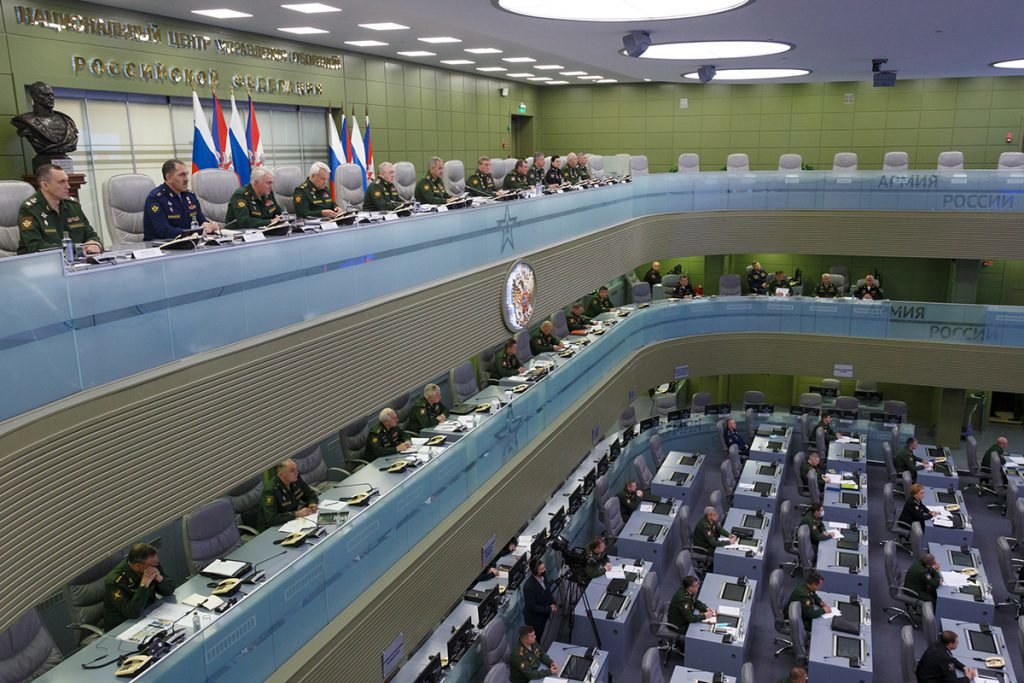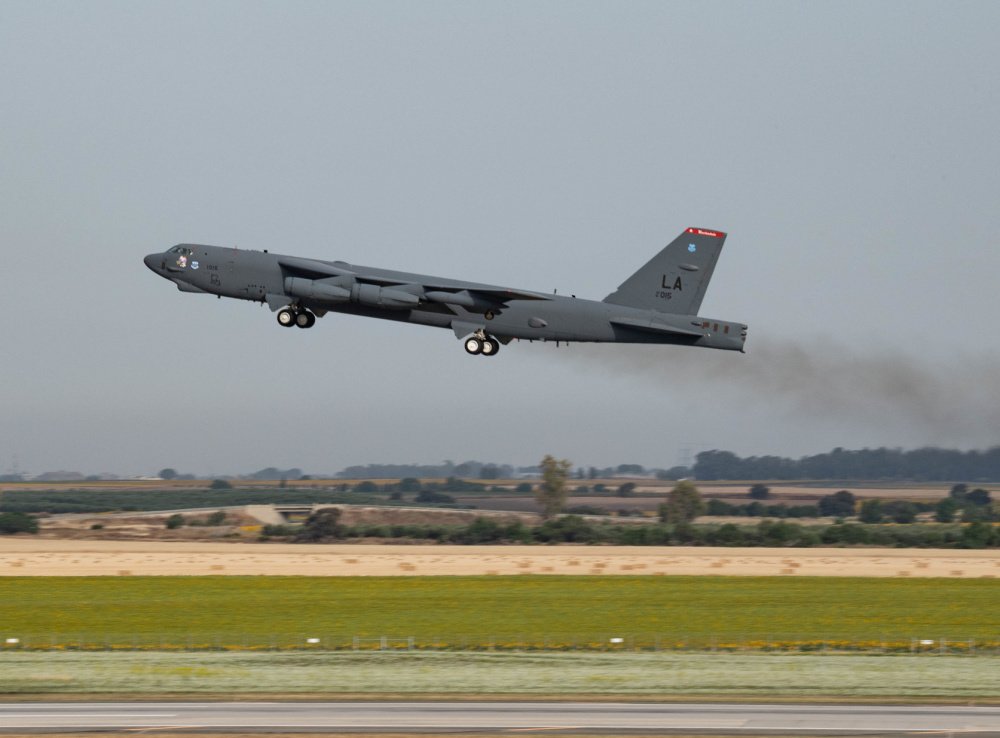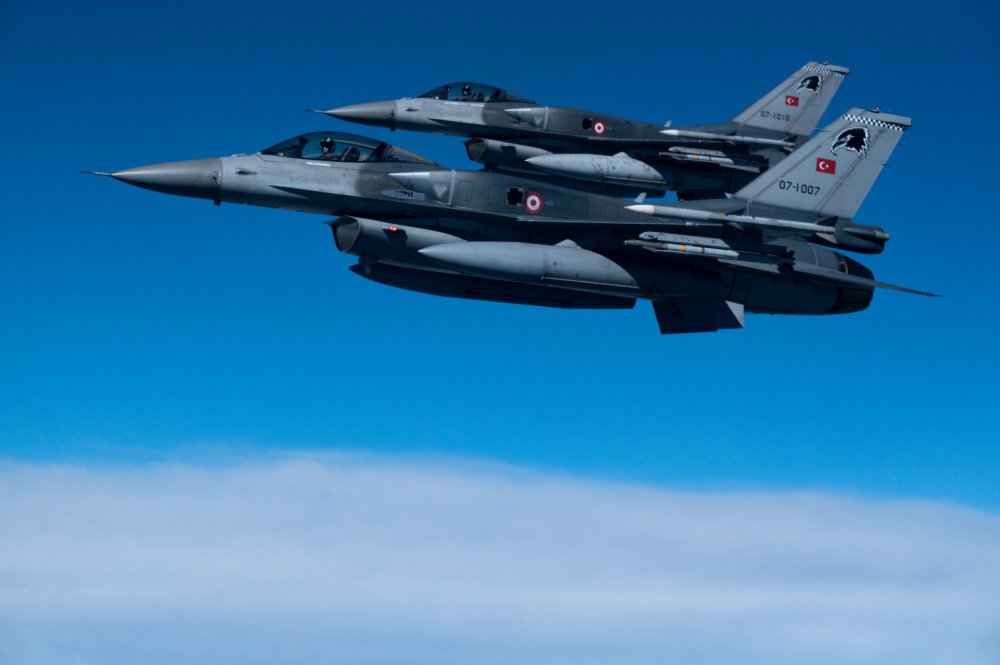Russia Rattles Its Saber, Announces Troop Buildup on NATO’s Frontier

The Russian Defense Ministry board met in Moscow on Monday, May 31, 2021. Photo by Ministry of Defense of the Russian Federation.
KYIV, Ukraine — While NATO conducts one of its largest military exercises in Europe in decades, Russia has signaled its displeasure by announcing plans to mass troops on its frontier with the Western military alliance.
During a Monday board meeting of the Russian Defense Ministry, Minister of Defense Sergei Shoigu announced the creation of 20 new military units and formations in Russia’s Western Military district — a region that borders Ukraine and Belarus, as well as the NATO countries of Estonia, Latvia, Lithuania, and Poland.
Shoigu said the military buildup is in response to territorial threats against Russia from the US and NATO. The news comes as NATO forces conduct war games across Europe, stretching from the Atlantic seaboard to the Black Sea. Comprising warships, dozens of aircraft, and thousands of troops, the NATO maneuvers are part of a US-led exercise called Defender-Europe 21.
“The actions of our Western counterparts are destroying the security system in the world and forcing us to take adequate countermeasures,” Shoigu said, according to a statement published by the Ministry of Defense of the Russian Federation. “We are constantly improving the combat composition of the troops. By the end of the year, about 20 formations and military units will be formed in the Western Military District.”
Shoigu added that the new units deployed toward NATO’s eastern frontier will be accompanied by “the delivery of advanced armaments and military hardware.” That materiel will amount to some 2,000 new weapons systems and other equipment, according to the Russian defense chief.
Russia is also planning war games with Belarus in September.
Shoygu tells collegium the Western military threat is forcing RF MOD to deploy 20 new formations and units in the Western MD this year. It's also getting about 2,000 weapons systems and other major equipment. https://t.co/iKeKI0PlMp pic.twitter.com/cmDWTb2g62
— Russian Defense Policy (@russiandefpolic) May 31, 2021
Some experts say the Russian announcement — while attention grabbing — may be more bluster than substance.
For one, it may take years to fully equip, arm, and staff the new units. Also, the Russian military, writ large, is not in the midst of the kind of expansion needed to grow its presence in the West by 20 units while simultaneously maintaining its current force posture in other regions. Consequently, many of these new units will likely face manpower and equipment shortages once they are officially established.
“[The Russian military] is expanding in number and size of formations, but the force in terms of personnel is not growing tremendously to match,” Michael Kofman, director of the CNA Corp.’s Russia Center and a fellow at the Woodrow Wilson Center’s Kennan Institute, wrote Monday on Twitter.
Comprising 28,000 personnel from 26 nations, Defender-Europe 21 is intended to simulate the transport of personnel and materiel from the US to Europe in the event of an attack on a NATO ally.
“NATO is there to defend all our allies, and this exercise sends a message about our ability to transport a large number of troops, equipment across the Atlantic, across Europe and also to project maritime power,” NATO Secretary-General Jens Stoltenberg told The Associated Press.
“NATO is ready,” Stoltenberg added.

The Russian Ministry of Defense claimed in its Monday statement that Defender-Europe 21 is the “largest exercise in the past 30 years,” comprising “up to 40 thousand military personnel.”
Over the past several years, the US Air Force’s Global Strike Command has ratcheted up the pace of its bomber task force missions across Europe and in the Arctic — advertising to Russia that US strategic bombers are ready and able to respond to global threats at a moment’s notice. Underscoring that trend, US Air Force B-52H Stratofortress strategic bombers flew a mission over the terrain of all European NATO members on Monday.
“Today’s mission is an awesome demonstration of NATO air superiority and together there is no challenge we cannot tackle,” Air Force Gen. Jeff Harrigian, NATO Allied Air Command and US Air Forces in Europe-Air Forces Africa commander, said in a Monday release.
According to the US Air Forces in Europe-Air Forces Africa statement: “Strategic bombers contribute to stability around the world, as they are intended to deter conflict rather than instigate it. If called upon, U.S. aircraft offer rapid response capabilities at any time and in any theater.”

Moscow claims the US bomber missions threaten Russia’s security. In a statement posted to its website on Monday, the Russian Ministry of Defense said: “The situation in the Western strategic direction is characterized by an increase in military threats. Over the past 7 years, the intensity of flights of the US Air Force’s strategic bomber aviation in Europe has grown 14 times.”
Russia’s military chief also highlighted the increased presence of NATO warships in the Baltic Sea as a threat to Russia.
“At the same time, the US and NATO continue to expand the scope of operational and combat training near our borders,” Shoigu said Monday, according to the Russian Defense Ministry’s website.
Russia sent shock waves across the West earlier this year by massing tens of thousands of troops near Ukraine’s borders.
In their country’s eastern Donbas region, Ukrainian troops remain engaged in a seven-year-old trench war against a combined force of Russian regulars, pro-Russian separatists, and foreign mercenaries. The conflict has so far killed some 14,000 Ukrainians and displaced 1.7 million people from their homes, according to the United Nations.
“What you see is a pattern of Russian behavior, where Russia over the last years have invested heavily in new modern military capabilities from conventional to nuclear weapon systems,” Stoltenberg said during a Monday press conference.
“This is one of the main reasons why NATO, in the last years, have increased readiness of our forces and also why we have deployed battletroops to the eastern part of our alliance,” Stoltenberg said.
While not a member of NATO, Ukraine is scheduled to participate in Defender-Europe 21.

Since Russia’s 2014 invasion of Ukraine, the US and NATO have increased the pace of their European military exercises to levels unseen since the Cold War. The Western military alliance (originally conceived to oppose the Soviet Union) has also collectively pledged to boost military spending.
At the July 2016 NATO summit in Warsaw, Poland, alliance leaders announced the rotational deployment of four 1,000-troop-strong combat battalions — known as multinational battle groups — to Poland, Estonia, Latvia, and Lithuania. Those deployments are ongoing.
Many military experts consider NATO’s Baltic deployments to be “tripwire forces,” presumably meant to deter Russia from an attack due to the risk of spurring a response by the entire Western alliance to defend its forward units.
NATO also fields a Very High Readiness Joint Task Force, comprising about 6,000 troops and based in Poland, which is tasked to “respond to emerging security challenges posed by Russia,” according to a statement on the alliance’s website.

Moscow’s military aggression in Ukraine has also spurred former Soviet and Warsaw Pact countries to become a de facto anti-Moscow military bloc. In July 2020, Poland signed a deal with Ukraine and Lithuania to form a three-way defense pact called the Lublin Triangle, which is meant to boost the three countries’ defenses against Russian aggression.
The Obama White House began the European Reassurance Initiative in June 2014 to fund operations in Europe to deter Russian military aggression in the wake of Moscow’s 2014 invasion of Ukraine. Totaling roughly $1 billion in 2014, the program was meant to be a temporary measure to deter Russia from military provocations. However, the program persists to this day.
Operation Atlantic Resolve, which falls under the European Reassurance Initiative funding umbrella, includes a broad gamut of exercises and temporary deployments of US military hardware and personnel throughout Europe.
“Since the Russian annexation of Crimea in 2014, DOD has also increased its rotations of temporary forces in and out of [European Command] to assure allies of the United States’ commitment to their security,” the Congressional Research Service reported in August 2020. “Dubbed ‘heel-to-toe’ rotations, air, ground and naval assets are deployed from the continental United States to conduct exercises with NATO allies for several months; they are then immediately replaced by other like units.”
According to the Congressional Research Service’s report, about 74,000 personnel are permanently assigned to US European Command. Those forces include 34,000 Army personnel, 27,000 Air Force personnel, 3,000 Marine personnel, and 10,000 Navy personnel.
Read Next:

BRCC and Bad Moon Print Press team up for an exclusive, limited-edition T-shirt design!
BRCC partners with Team Room Design for an exclusive T-shirt release!
Thirty Seconds Out has partnered with BRCC for an exclusive shirt design invoking the God of Winter.
Lucas O'Hara of Grizzly Forge has teamed up with BRCC for a badass, exclusive Shirt Club T-shirt design featuring his most popular knife and tiomahawk.
Coffee or Die sits down with one of the graphic designers behind Black Rifle Coffee's signature look and vibe.
Biden will award the Medal of Honor to a Vietnam War Army helicopter pilot who risked his life to save a reconnaissance team from almost certain death.
Ever wonder how much Jack Mandaville would f*ck sh*t up if he went back in time? The American Revolution didn't even see him coming.
A nearly 200-year-old West Point time capsule that at first appeared to yield little more than dust contains hidden treasure, the US Military Academy said.












